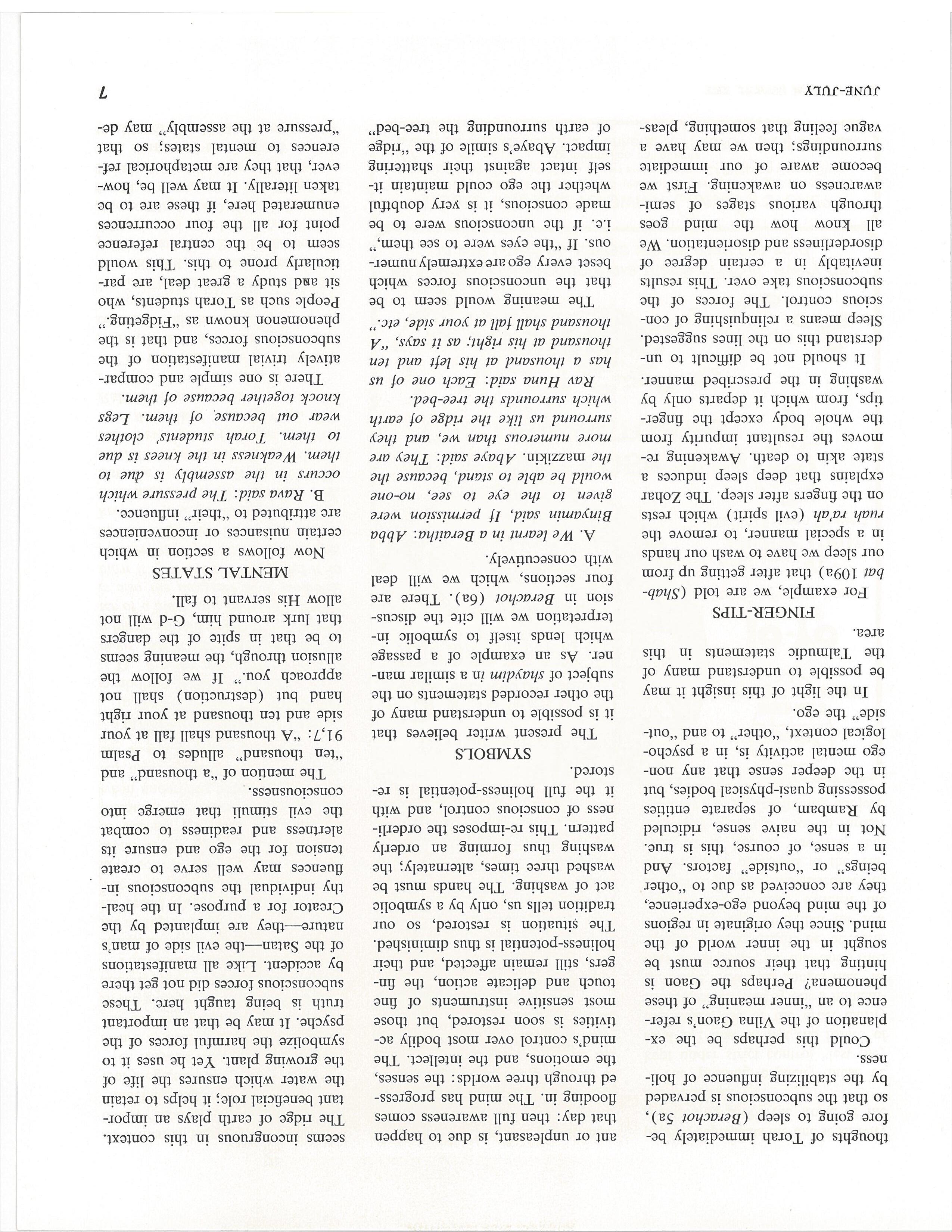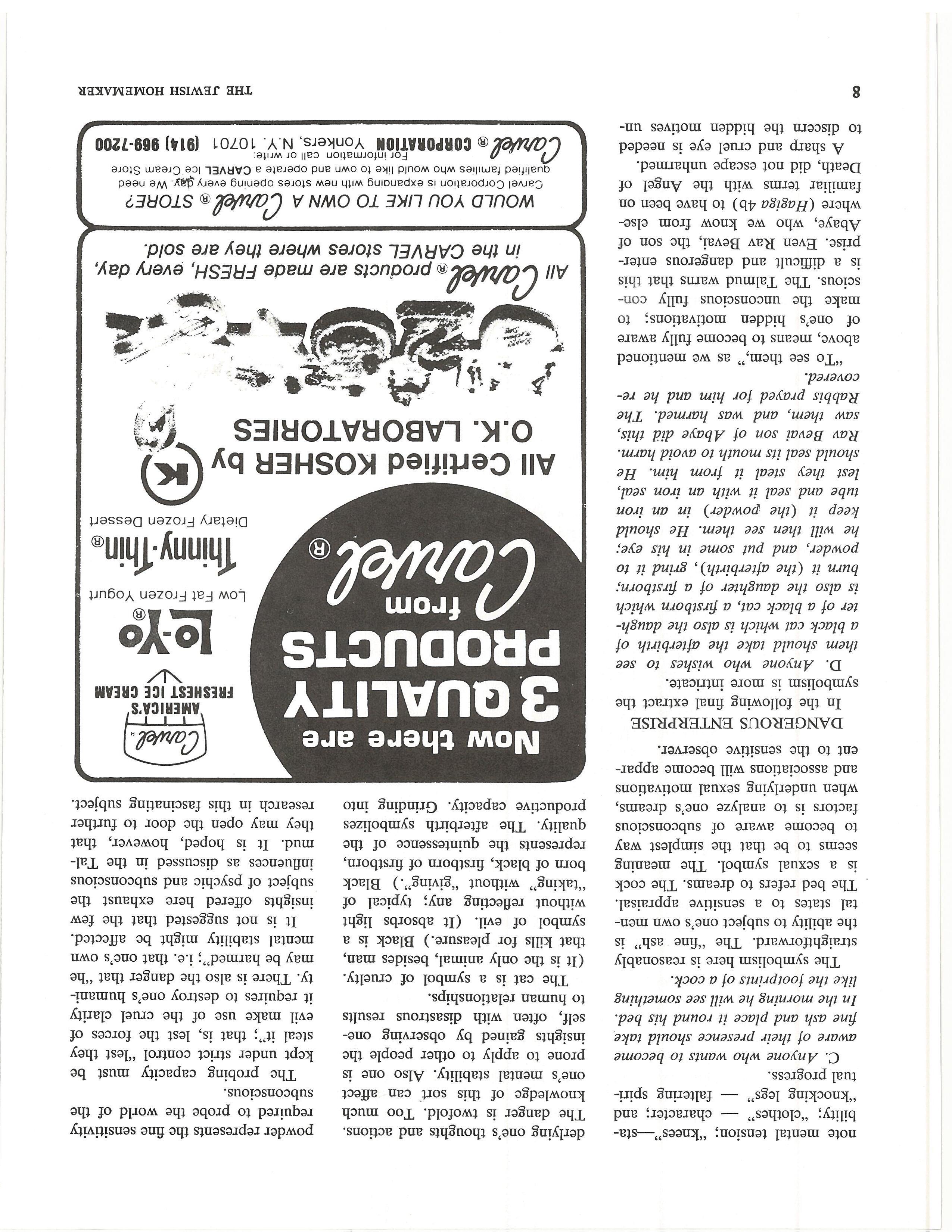
7 minute read
emo
by ARYEH CARMELL
Rambam (Maimonides) consider ed that demons were old wives’ tales (Mishnah Commentary, Avoda Za ra, chapte 4), while the Gaon of Vilna, 60) years later, forcefully maintained their reality, though conceding that they have an “inner meaning” (Biur Hagra, Yore Dea, 179, 13).
Advertisement
Are we now, in this post-modern ge, in a position to effect a recon ciliation, and also to suggest what that “inner meaning” might be?
Psychic Phenomena
Psychosomatic medicine has taught us that mental events can have very noticeable physical effects. Psychic phenomena are today under investi gation in many parts of the world, including Soviet Russia. “Polter geist” experiences, in which noises are heard, disturbances occur, arti des explode and objects are thrown about without apparent cause, have been fully documented in many dif ferent places over a period of more than four centuries. A careful com parison of these accounts reveals an interesting fact, not always ap parent to the authors themselves: the disturbances are invariably asso ciated with a boy or girl near the age of puberty. No convincing ex planation has ever been offered for these phenomena.
It is increasingly clear that the effects attributed in the past to demons must have been due to what we now refer to as subconscious and psychic forces. It has even been suggested that shayd, the Hebrew word for “demon” (Aramaic: shid da) is derived from the Aramaic verb shaddey, to throw, and is con nected with poltergeist phenomena.
Moral Sphere
In the Talmud these forces are often called mazzikin, or “harmful influences”. Those particularly vu! nerable to their attacks are stated to be persons alone at night, and in isolated places such as ruins or deserts (Berachot 3b). The precise nature of the harm they inflict is not stated, but it would seem to be mental rather than pIiy~ical. In Rosh Hashana (28b) “demonic compulsion” is equated with insani ty. The fact that they are thought of as the forces of Samael, or Satan (Zohar III, 282) would seem to in dicate that their origin is to be sought in the moral sphere, for “Sa tan” is another name for yetzer ha ra, the evil side of man’s nature (Bava Batra 1 6b). Their effects may be counteracted by reciting the Shema or occupying oneself with
THE JEWISH HOMEMAKER
thoughts of Torah immediately be fore going to sleep (Berachot 5a), so that the subconscious is pervaded by the stabilizing influence of holi ness.
Could this perhaps be the ex planation of the Vilna Gaon’s refer ence to an “inner meaning” of these phenomena? Perhaps the Gaon is hinting that their source must be sought in the inner world of the mind. Since they originate in regions of the mind beyond ego-experience, they are conceived as due to “other beings” or “outside” factors. And in a sense, of course, this is true. Not in the naive sense, ridiculed by Rambam, of separate entities possessing quasi-physical bodies, but in the deeper sense that any nonego mental activity is, in a psycho logical context, “other” to and “out side” the ego.
In the light of this insight it may be possible to understand many of the Talmudic statements in this area.
FINGER-TIPS
For example, we are told (Shab bat 109a) that after getting up from our sleep we have to wash our hands in a special manner, to remove the ruah ra’ah (evil spirit) which rests on the fingers after sleep. The Zohar explains that deep sleep induces a state akin to death. Awakening re moves the resultant impurity from the whole body except the finger tips, from which it departs only by washing in the prescribed manner.
It should not be difficult to un derstand this on the lines suggested. Sleep means a relinquishing of con scious control. The forces of the subconscious take over. This results inevitably in a certain degree of disorderliness and disorientation. We all know how the mind goes through various stages of semiawareness on awakening. First we become aware of our immediate surroundings; then we may have a vague feeling that something, pleas- ant or unpleasant, is due to happen that day: then full awareness comes flooding in. The mind has progress ed through three worlds: the senses, the emotions, and the intellect. The mind’s control over most bodily ac tivities is soon restored, but those most sensitive instruments of fine touch and delicate action, the fin gers, still remain affected, and their holiness-potential is thus diminished. The situation is restored, so our tradition tells us, only by a symbolic act of washing. The hands must be washed three times, alternately; the washing thus forming an orderly pattern. This re-imposes the orderli ness of conscious control, and with it the full holiness-potential is re stored.
Symbols
The present writer believes that it is possible to understand many of the other recorded statements on the subject of shaydim in a similar man ner. As an example of a passage which lends itself to symbolic in terpretation we will cite the discus sion in Berachot (6a). There are four sections, which we will deal with consecutively.

A. We learnt in a Beraitha: Abba Binyamin said, If permission were given to the eye to see, no-one would be able to stand, because the the mazzikin. Abaye said: They are more numerous than we, and they surround us like the ridge of earth which surrounds the tree-bed.
Ray Huna said: Each one of us has a thousand at his left and ten thousand at his right; as it says, “A thousand shall fall at your side, etc.”
The meaning would seem to be that the unconscious forces which beset every ego are extremelynumer ous. If “the eyes were to see them,” i.e. if the unconscious were to be made conscious, it is very doubtful whether the ego could maintain it self intact against their shattering impact. Abaye’s simile of the “ridge of earth surrounding the tree-bed” seems incongruous in this context. The ridge of earth plays an impor tant beneficial role; it helps to retain the water which ensures the life of the growing plant. Yet he uses it to symbolize the harmful forces of the psyche. It may be that an important truth is being taught here. These subconscious forces did not get there by accident. Like all manifestations of the Satan—the evil side of man’s nature—they are implanted by the Creator for a purpose. In the heal thy individual the subconscious in fluences may well serve to create tension for the ego and ensure its alertness and readiness to combat the evil stimuli that emerge into consciousness.
The mention of “a thousand” and “ten thousand” alludes to Psalm 91,7: “A thousand shall fail at your side and ten thousand at your right hand but (destruction) shall not approach you.” If we follow the allusion through, the meaning seems to be that in spite of the dangers that lurk around him, G-d will not allow His servant to fall.
Mental States
Now follows a section in which certain nuisances or inconveniences are attributed to “their” influence.
B. Rava said: The pressure which occurs in the assembly is due to them. Weakness in the knees is due to them. Torah students’ clothes wear out because of them. Legs knock together because of them.
There is one simple and compar atively trivial manifestation of the subconscious forces, and that is the phenomenon known as “Fidgeting.” People such as Torah students, who sit aNd study a great deal, are par ticularly prone to this. This would seem to he the central reference point for all the four occurrences enumerated here, if these are to be taken literally. It may well be, how ever, that they are metaphorical ref erences to mental states; so that “pressure at the assembly” may de note mental tension; “knees”—sta bility; “clothes” character; and “knocking legs” faltering spiri tual progress.
C. Anyone who wants to become aware of their presence should take fine ash and place it round his bed. In the morning he will see something like the footprints of a cock.
The symbolism here is reasonably straightforward. The “fine ash” is the ability to subject one’s own men tal states to a sensitive appraisal. The bed refers to dreams. The cock is a sexual symbol. The meaning seems to be that the simplest way to become aware of subconscious factors is to analyze one’s dreams, when underlying sexual motivations and associations will become appar ent to the sensitive observer.
Dangerous Enterprise
In the following final extract the symbolism is more intricate.
D. Anyone who wishes to see them should take the afterbirth of a black cat which is also the daugh ter of a black cat, a firstborn which is also the daughter of a firstborn; burn it (the afterbirth), grind it to powder, and put some in his eye; he will then see them. He should keep it (the powder) in an iron tube and seal it with an iron seal, lest they steal it from him. He should seal its mouth to avoid harm. Ray Bevai son of Abaye did this, saw them, and was harmed. The Rabbis prayed for him and he re covered.
“To see them,” as we mentioned above, means to become fully aware of one’s hidden motivations; to make the unconscious fully con scious. The Talmud warns that this is a difficult and dangerous enter prise. Even Ray Bevai, the son of Abaye, who we know from else where (Hagiga 4b) to have been on familiar terms with the Angel of Death, did not escape unharmed.
A sharp and cruel eye is needed to discern the hidden motives un derlying one’s thoughts and actions. The danger is twofold. Too much knowledge of this sort can affect one’s mental stability. Also one is prone to apply to other people the insights gained by observing one self, often with disastrous results to human relationships.
The cat is a symbol of cruelty. (It is the only animal, besides man, that kills for pleasure.) Black is a symbol of evil. (It absorbs light without reflecting any; typical of “taking” without “giving”.) Black born of black, firstborn of firstborn, represents the quintessence of the quality. The afterbirth symbolizes productive capacity. Grinding into powder represents the fine sensitivity required to probe the world of the subconscious.
The probing capacity must be kept under strict control “lest they steal it”; that is, lest the forces of evil make use of the cruel clarity it requires to destroy one’s humani ty. There is also the danger that “he may be harmed”; i.e. that one’s own mental stability might be affected.
It is not suggested that the few insights offered here exhaust the subject of psychic and subconscious influences as discussed in the Tal mud. It is hoped, however, that they may open the door to further research in this fascinating subject.








